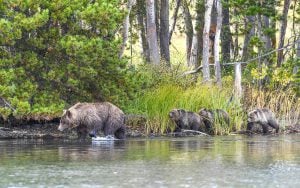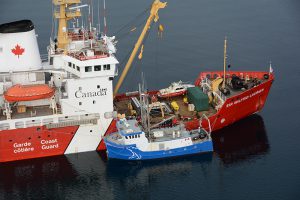
Wildlife
Do not disturb: Practicing ethical wildlife photography
Wildlife photographers on the thrill of the chase — and the importance of setting ethical guidelines
- 2849 words
- 12 minutes
This article is over 5 years old and may contain outdated information.
History

August 29, 2014, 20:00 Mountain Standard Time
We started our day at the south entrance of Requisite Channel. As expected, the morning weather was largely a re-run of yesterday’s overcast, windy conditions, limiting our operations to some navigational aids work while we moved northeastward into the southern search area. Tomorrow will be our official start date for our leg of the Victoria Strait Expedition, delayed slightly to accommodate the ice conditions (by now, it should be clear that we accommodate the ice, it does not accommodate us).

Today’s highlight for all aboard was the sighting of a healthy female polar bear and her two cubs in the pack ice of Storis Passage. We brought the ship to a halt at the edge of the ice and watched the family from several hundred metres away as they moved across the ice and swam in the water. Getting quick glimpses of polar bears, Arctic foxes, Arctic cod and other northern wildlife in their natural habitats are always uplifting. Lucky for us that we have several gifted photographers aboard, including our own winchman Cory Glencross, who captured this week’s best animal images.
By the afternoon, the wind began to die down and our partners returned to full operations. The Canadian Hydrographic Service sent both the Gannet and Kinglett back into the water for surveys and Parks Canada staff assembled their autonomous underwater vehicle out on the hatch in preparation for sea trials. By early evening, we gathered all vessels and equipment back onboard and turned our sights toward the southern end of Alexandra Strait to anchor.
The Canadian Hydrographic Service completed a preliminary electronic charting of this new route in 2012 taking us further south into Alexandra Strait. Prior to their work, only two vessels were known to have sailed this specific route — one of which, the U.S. Coast Guard ship Storis, left behind a very narrow track line of soundings around 1957. This significant achievement by the Canadian Hydrographic Service, which may ultimately provide an alternative routing for safe transit between Victoria Strait to Storis Passage, demonstrates just one more leap forward by our partners.
Before I sign off, I’d like to pass along congratulations to the captain, crew, and expedition team members (including some friends of mine) aboard the Canadian Coast Guard icebreakers CCGS Louis S. St-Laurent and the CCGS Terry Fox, for their successful voyage to the North Pole this week. Well done!
Parked at the North Pole!!! #LSSL #CCGArctic
DFONL (@DFO_NL) August 28, 2014
Are you passionate about Canadian geography?
You can support Canadian Geographic in 3 ways:

Wildlife
Wildlife photographers on the thrill of the chase — and the importance of setting ethical guidelines

History
This year's search is about much more than underwater archaeology. The Victoria Strait Expedition will contribute to northern science and communities.

People & Culture
These 10 members of Canadian Geographic’s online Photo Club are making waves with their unique perspectives on Canadian wildlife and landscapes

History
Introductory insights into the Canadian Coast Guard’s role in the search area